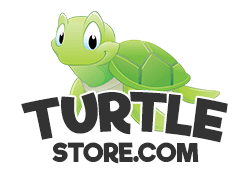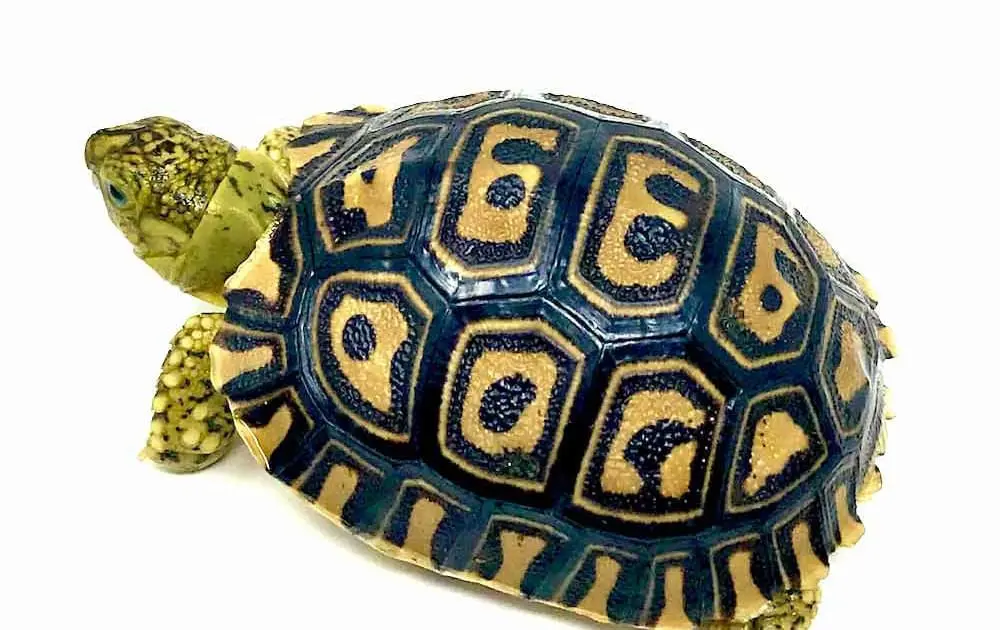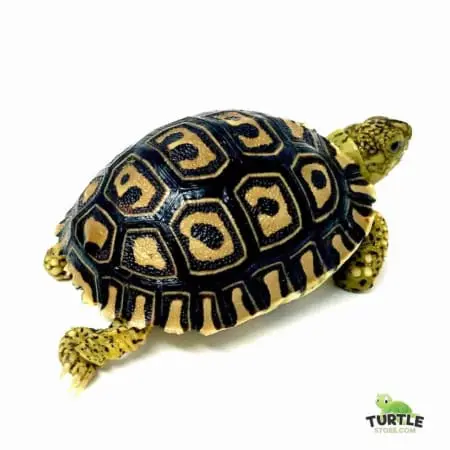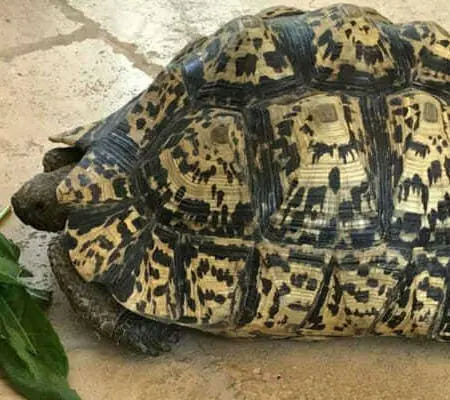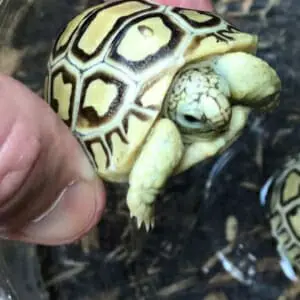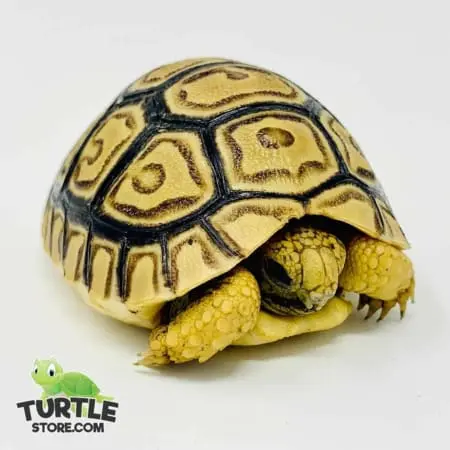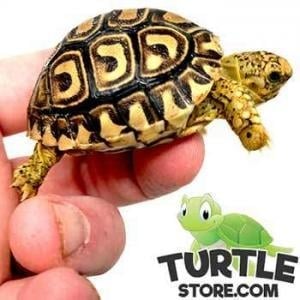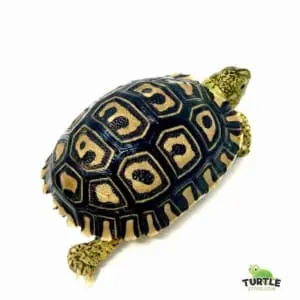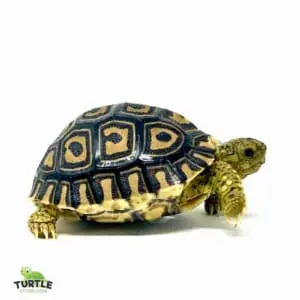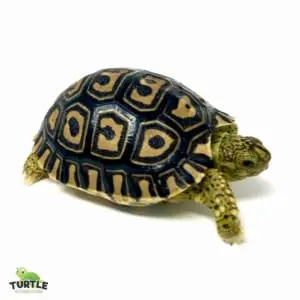baby Leopard tortoise diet
Variety is key when talking about what to feed your new leopard tortoise. It isn’t really about one thing, it is about feeding a wide variety of high-quality greens and veggies. By feeding a variety you will ensure not to “overdose” your tortoise on certain things. For example, spinach is bad.
If you feed spring mix that contains spinach as one of 15 ingredients, it will not be too much where you need to worry about spinach. If all that you ever feed is spring mix, then you have a problem. Turtle store uses a mixture we chop daily of Romaine, Kale, Dandelion, Spring Mix, Endive, Collard, Mustard, and Beet Greens. In addition, we soak our mazuri tortoise chow in water mixed with a 50:50 ratio of calcium with D3 AND Vionate (a multi-vitamin and mineral powder).
Baby Leopard tortoise for sale – Leopard tortoise water
Giving your baby leopard tortoises access to water is preferred, and soaking daily is required. Soak your baby tortoise in a shallow soaking dish with opaque sides so the tortoise cannot see out. Soak for 10 minutes in 85-88 degree warm water once daily. Typically soaking your tortoise and then placing them directly atop their pile of greens and Mazuri is best each morning. Establishing a daily routine when possible will benefit your tortoise a great deal.
Leopard Tortoise Care Sheet
A leopard tortoise for sale is some of the most popular medium-sized tortoises among tortoise keepers for a reason. Fairly easy to keep, and very docile yet friendly, the leopard tortoise has a wonderful personality and makes a fantastic addition to any reptile family. Pardalis Babcocki is the smaller of the 2 leopard tortoise species (Pardalis Pardalis is the larger of the 2).
We highly recommend well started 6 month old or yearling baby leopard tortoises for sale over the more fragile leopard tortoise hatchling for sale for those without baby tortoise keeping experience. Easier to care for well started 6-Month-old leopard tortoise babies for sale can be found by selecting either hatchling, 6-month-old well-started baby or well-started yearling from the drop-down menu.
Leopard tortoise care
Our staff biologist has prepared an in-depth, easy to understand leopard tortoise care guide which we have provided below. We recommend that all new leopard tortoise owners spend a bit of time getting educated on this wonderful species of tortoise for sale. Like all species of tortoise leopards will require certain parameters within their habitat and diet to remain healthy and thrive.
- Leopard tortoise care
- leopard tortoise diet
- baby leopard tortoise
- leopard tortoise habitat
- giant leopard tortoise temperature
- leopard tortoise humidity
- baby leopard tortoise lighting
- Giant South African leopard tortoise
- leopard tortoise size
- leopard tortoise substrate
- African leopard tortoise lifespan
- all baby tortoises for sale
Caring for a leopard tortoise is moderate a task, so long as you invest the time to learn. Leopard tortoises are medium to large sized tortoises and therefore once they grow will require a larger habitat, at full maturity of say 4×6′, though larger is always better. Multiple leopard tortoises may be housed together in groups of up to 6, but size should be 5.5 cubic feet larger per female.
Using a tortoise table, or tortoise house kit will work, just pay close attention to temperature and humidity. A baby tortoise, in general, will need higher humidity as the main variable for success.
Leopard tortoises and humidity
Humidity is important with all baby tortoise species, including the Testudo tortoise family. Baby leopard tortoises require humidity in the area of 75%. When kept indoors, the habitats tend to be on the dryer side and therefore will require some work to increase the humidity where need be. Using a lid, or some type of closed system will help tremendously.
Here at the Turtle store, we raise all of our baby torts (Russians, Sulcata, Leopard, Red-footed, Yellow-footed, Greeks, Egyptians, Marginated, etc) in closed systems with high humidity and LOW air movement. From years of breeding baby tortoises for sale, we now have mastered the art of raising these beautiful leopard tortoise hatchlings.
baby Leopard tortoise temperature

Baby leopard tortoises should be kept with an ambient temperature of 86 degrees. A cold spot of 80 is fine and a warm spot of 95 is also nice, however, the ambient temp remains the most important. Here at Turtle store, our main concern is the ambient temp and not getting too cold. We focus more on this than the temperature gradient that is so widely talked about. Finding that the tortoises’ theme to thrive with a median temperature of 86, we now maintain this throughout our daytime enclosure temperatures. Evening temps are allowed to drop into the high 70s, however with very slow moving, humid air, it seems a tad warmer and “muggier” for the tortoises.
baby Leopard tortoise diet
Variety is key when talking about what to feed your new leopard tortoise. It isn’t really about one thing, it is about feeding a wide variety of high-quality greens and veggies. By feeding a variety you will ensure not to “overdose” your tortoise on certain things. For example, spinach is bad. If you feed spring mix that contains spinach as one of 15 ingredients, it will not be too much where you need to worry about spinach. If all that you ever feed is spring mix, then you have a problem. Turtle store uses a mixture we chop daily of Romaine, Kale, Dandelion, Spring Mix, Endive, Collard, Mustard, and Beet Greens. In addition, we soak our mazuri tortoise chow in water mixed with a 50:50 ratio of calcium with D3 AND Vionate (a multi-vitamin and mineral powder).
Baby Leopard tortoise for sale – Leopard tortoise water
Giving your baby leopard tortoises access to water is preferred, and soaking daily is required. Soak your baby tortoise in a shallow soaking dish with opaque sides so the tortoise cannot see out. Soak for 10 minutes in 85-88 degree warm water once daily. Typically soaking your tortoise and then placing them directly atop their pile of greens and Mazuri is best each morning. Establishing a daily routine when possible will benefit your tortoise a great deal.
Leopard tortoise UVB lighting
UVB light exposure is extremely important for all tortoises, including baby leopard tortoises. We recommend a Reptisun UVB 10.0 lamp, T5 (tube style). Screw in lamps like the cheap spirals are not recommended and really do not have much of a radius of coverage. Think about the tortoise being outside, getting constant UVB and UVA from every angle. Now, think about the exposure they will get in their habitat inside or outside your home, and try to make them similar. Not easy, is it? Using a T5 high output lamp will give you the best scenario. Using the 10% lamp is good, however for distances 15-24″ above the tortoise, a 12% lamp is recommended. Arcadia UVB lamps are the best in our opinion, though a tad more pricey, they also last twice as long.
Leopard tortoise habitat
Baby leopard tortoise can exist in something as small as a 24×12″ sweater box. Keeping humidity high is key, so these work. Using a fish tank is not recommended but also can work if set up properly. You will want to cover the sides so that the tort cannot see out, as that will cause he or she to become anxious and constantly try to escape via the clear see-thru side(s). We like to use the 24″x15″x48″long PVC style single glass front reptile cages available at reptile basics. For UVB fitting them out with a 36″ T5 10.0 fixture is easy.
Leopard tortoise substrate
For substrate, we recommend a nice mixture of 50:50 potting soil and potting mix (organic). Be sure there are no additives or fertilizers included as that could kill your tort. Baby leopard tortoises do burrow so providing 4″ of the substrate is recommended and spraying it down with a pressure sprayer daily is great. Spraying the soil and your tort(s) in the morning to simulate a morning dew so to speak works create. One added but important benefit of doing this is creating a super humid microclimate for your tortoise should they choose to burrow. It is in these microclimates in which baby tortoise exists in the wild. Remember not to call the Greek tort a leopard turtle or leopard turtle for sale, it’s a tortoise!
Handling a leopard tort and leopard tortoises Temperament
Leopard tortoises are shy and will withdraw their head and limbs until they are used to their home/habitat. Over time, however, they generally learn to recognize their keepers and will come for food and if handled in the correct manner will become great pets. If you’re considering where to buy leopard tort, choose Turtle Store for the nicest baby leopard tortoise for sale anywhere. Lastly, if you mistakenly ended up here but were searching for leopard geckos, or a leopard gecko for sale, visit our gecko store over at CB Reptile. If you are looking for a turtle for sale, we recommend our turtles for sale section or turtle store.
Leopard tortoise hatchlings for sale
Baby leopard tortoises for sale are very good climbers and you will often find them on top of their tortoise houses so keeping an eye on them in case they flip themselves in something that leopard tortoise owners will learn quickly! Our baby leopard tortoise are vibrant in color and have beautiful patterns. With a Biologist ON SITE all of our tortoises for sale come with our full live arrival and 7-day health guarantee.
At Turtlestore.com we pride ourselves on selling only top-notch baby leopard tortoises, ready to ship year-round to you via UPS or FedEx Overnight in heated, vented and insulated shipping boxes. One shipping charge covers up to 4 tortoises.
Leopard Tortoises for sale
We have some beautiful leopard tortoises in stock. These baby leopard tortoises have some amazing patterns and an ivory to tan color on their heads, bodies, and shells. We only select top quality captive leopard tortoise breed stock focusing on healthy active tortoises with vivid color and markings.
Leopard tortoises are fantastic animals with great outgoing personalities and beautiful colors and markings. They will eventually eat out of the owner’s hand and learn fast to come when they see you. Our baby leopard tortoises for sale are top notch and ready to ship to you via UPS or FedEx Overnight in heated or cooled insulated shipping containers and come with our live arrival and full 7 day health guarantee. One shipping charge covers up to 4 leopard tortoises for sale. If you are looking for more information on leopard tortoise care, visit our leopard tortoise care sheet.
The best leopard tortoises for sale from the Turtle Store
Turtle store offers leopard tortoise hatchlings for sale, as well as well started baby Pardalis babocki and Pardalis Pardalis leopard tortoises. Looking for a larger leopard tortoise for sale? Consider the Giant South African leopard tortoise. As far as size/age goes, we also offer yearlings and juvenile tortoises for sale online. Our breed stock of adult leopard tortoises for sale is composed of some of the nicest leopard tortoises in the world. Our biologist has put together one of the nicest leopard tortoise breeding groups in the world. Because of this, we are able to offer some of the nicest baby leopard tortoises for sale online anywhere. Captive bred baby tortoises for sale should be the only that you choose when shopping for the right tortoise breeders.
Over 25 Species of captive bred tortoises for sale
Other species of tortoise for sale offered here include giant tortoises like the Aldabra tortoise, Sulcata tortoise, Burmese mountain tortoise and more. Medium size species include the leopard tortoise, red-footed tortoise, yellow footed tortoise, mountain tortoise, Burmese star tortoise and the giant leopard tortoise. small tortoise breeds include Hermann’s tortoise, Greek Tortoise, Indian Star tortoise, Pancake Tortoise, Russian tortoise, and the Egyptian tortoise. Above all, we’ve got the widest selection of tortoise for sale in the USA, including baby tortoise for sale, juveniles and adult tortoises for sale.
